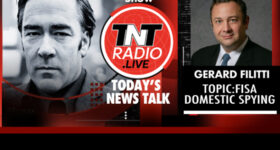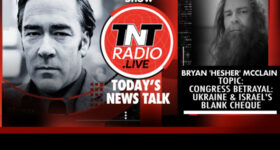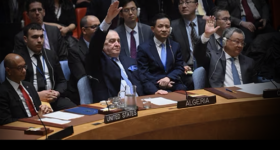James Tracy
Memory Hole
News reportage of mass shooting events over the past several years has changed markedly from coverage of such incidents just a few decades ago.
Some media critics and researchers have pointed to mass shootings, including those transpiring on January 8, 2011 in Tucson Arizona, July 20, 2012 in Aurora Colorado, December 14, 2012 in Newtown Connecticut, and the recent October 1, 2015 event at Umpqua Community College in Roseburg, Oregon, to suggest that these incidents may have been influenced or even partly contrived with involvement of federal authorities.
They reinforce their arguments with an impressive array of conflicting media reports and unrealistic “official” narratives concerning these events as potential evidence of government deception.
Whether or not such claims are true, there can be no doubt that each referenced event has been inordinately sensationalized by corporate news media and national political leaders to advocate for stricter gun control, mental health, and police state measures, even though criminologists maintain that the number of mass shootings has not increased since the 1990s.

‘POLITICIZED’ – President Obama addresses the nation four hours after the mass shooting event at Umpqua Community College in Roseburg, Oregon on October 1, 2015. (Photo statesman)
Like the curious 1996 mass shootings in Dunblane Scotland and Port Arthur Australia – events capitalized on by political leaders in those countries to pass harsh gun control measures and expressly invoked by President Obama just hours after the Roseburg shooting – researchers and independent news media point to a potential agenda behind the intense publicization of mass shootings throughout the United States.
As this author has argued, although it may seem an extravagant assertion, one must ponder whether there is sufficient reason to consider whether certain US government agencies are involved “creating” or embellishing some of these mass shooting incidents. One need look no further than the history of Operation Gladio, or FBI involvement in what one investigative journalist terms the “manufacture” of terror events, documented respectively by scholar Daniele Ganser and journalist Trevor Aaronson, to conclude that a lavishly-funded military-intelligence-media complex has for at least forty years demonstrated a sheer contempt toward the Western body politic that has in some instances resulted in mass murder.
A hypothesis may be at least partly demonstrated that a similar dynamic holds true for mass shootings through careful analysis of news coverage on mass shootings transpiring prior to the heavy federal involvement in local and regional law enforcement and specific shooting incidents that have only intensified in the 14-year purported War On Terror.
The following preliminary examination suggests how the news consuming public was afforded much more lucid and enduring depictions of mass shootings by journalists in past decades. In other words, many years before internet technology became essential to assembling stories, journalists reported accurate and demonstrable facts to their readerships on mass shooting crime scenes and their dynamics in very short order, giving the reader abundant and consistent information to understand what really happened in such tragic events.
Reportage on mass shootings in the 1990s and prior is at significant variance with how such incidents are presented today. For example, in corporate news coverage of the December 14, 2012 Sandy Hook Elementary School massacre integral facets of the story changed in the immediate wake of the event. Conflicting information surrounded how the shooter gained entrance to the school’s interior, what weapons the shooter employed in his attack, the types of wounds the victims sustained, even the identity of the assailant and nature of the emergency response, all of which are fundamental features of a criminal investigation that in many past instances was quickly and unambiguously relayed to the public.
Similar features have plagued coverage of many other mass shootings in the US in recent years. At the Aurora Colorado theatre shooting in 2012 some eyewitnesses came forward to contend there were two or more culprits involved—a claim contradicting the official narrative that one James Holmes was the sole assailant.
Further, Aurora police chief Dan Oates stated to reporters immediately following the event that officers responded to the incident and apprehended Holmes in 90 seconds—a remarkably short time given the event’s almost certain chaos. Oates then states that his personnel eschewed ambulance service for injured parties, transporting the wounded to local hospitals in police cars—a startling and implausible admission by a leading law enforcement official with clear implications for probable negligence and civil liability.
.
Further, despite the movie theater being equipped with an extensive network of state-of-the-art video surveillance, to date no video footage has been released to the public that James Holmes was inside or for that matter anywhere near the premises in the period leading to the shooting. Along these lines, one eyewitness, Corbin Dates, asserted in several interviews with major media that there was more than one individual involved in the shooting—none of whom resembled Holmes.
Coverage of, and emergency response to, the October 2015 Umpqua Community College shooting was similarly bizarre. “Early media reports stated that a 20-year-old male had fatally shot at least 13 people,” 21st Century Wire’s Shawn Helton writes:
“but that was later downgraded to 10 fatalities including the gunman, with another seven injured before being changed again to 10 killed and nine wounded at the UCC campus. Eventually, the suspected gunman turned out to be 26-year old Chris Harper Mercer, who we were told repeatedly had been ‘neutralized’ (shot) by police during a gun battle on campus. However, 48-72 hours later, it was revealed that the ‘lone gunman’ Harper Mercer had committed suicide, dying of a self-inflicted gunshot.”
https://www.youtube.com/watch?v=CvURi4UEvaA
.
The above inconsistencies and implausible features in official narratives of US mass shootings resound in those listed below. Nevertheless they are repeated almost without question by corporate news media.
Here’s a list containing some of the more questionable shooting events in recent history…
• Isla Vista Killings May 23, 2014
• Florida State U Shooting November 20, 2014
• Seattle Pacific Shooting June 5, 2014
• Las Vegas Shooting June 8, 2014
• Spring Texas Shooting July 9, 2014
• Charleston Church Shooting June 17, 2015
• Chattanooga Shooting July 16, 2015
• Lafayette Shooting July 23, 2015
• WDBJ Journalists Shooting August 26, 2015
The question remains, have such anomalies and informational lacunae characterized official pronouncements of major mass shooting incidents before federal law enforcement agencies became so heavily involved in processing crime scenes and advising local police and emergency response services?
Journalistic coverage of three significant mass shootings where federal involvement is absent is presented below to argue that more recent mass shooting events possessing curious and seemingly inexplicable features in fact require far closer scrutiny from capable intellects and the broader public than they have thus far received.
University of Texas Shooting – 1966
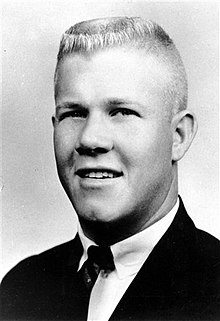 The most well-known mass shooting in US history took place at midday on August 1, 1966 when 25-year-old Charles J. Whitman terrorized the University of Texas at Austin’s campus from the observation ledge of the 27-story UT Tower, utilizing an array of rifles to shoot 45 pedestrians, 12 fatally. On August 2nd, two comprehensive reports of the event, detailed the horror though police and eyewitness testimony. “Students, professors and visitors ran for cover,” United Press International reporters on the scene wrote.
The most well-known mass shooting in US history took place at midday on August 1, 1966 when 25-year-old Charles J. Whitman terrorized the University of Texas at Austin’s campus from the observation ledge of the 27-story UT Tower, utilizing an array of rifles to shoot 45 pedestrians, 12 fatally. On August 2nd, two comprehensive reports of the event, detailed the horror though police and eyewitness testimony. “Students, professors and visitors ran for cover,” United Press International reporters on the scene wrote.
In the story’s initial paragraphs the reader is apprised of the event’s resolution: “An off-duty policeman, Romero Martinez, who had responded to a call on his radio, inched his way around a wall at the top of the tower and fired six bullets into the sniper with his service revolver after the sniper shot at him.”
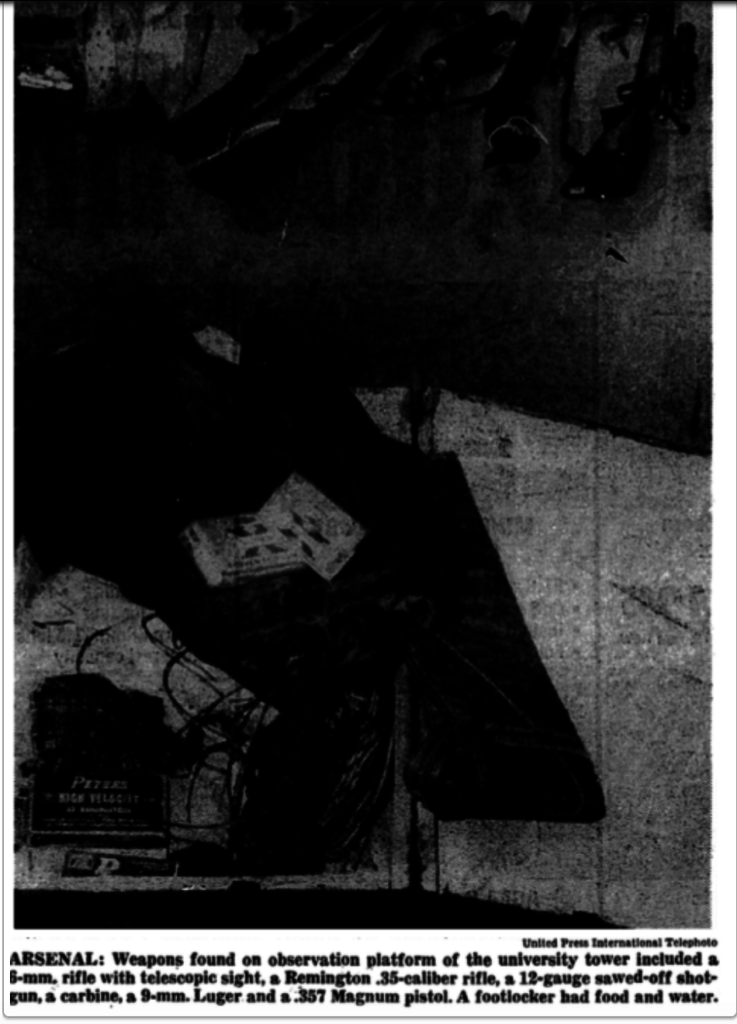 The shooting is rendered more vivid through testimony from an array of traumatized witnesses relating their experiences:
The shooting is rendered more vivid through testimony from an array of traumatized witnesses relating their experiences:
“Denver Dolman, who operated a bookstore at the edge of the campus, said a young Negro student was riding his bicycle toward the Texas Union Building … The bicycle wavered and the boy appeared to fall onto the sidewalk.” “John Scott Allen, 18, a freshman, was watching.”
A bullet smashed through a window and struck him in the right forearm.” “Leland Ammons, a law student, was standing beside Billy Speed, a policeman, when Mr. Speed was shot.”
“Ruth Kiykendall, who works on the 18th floor of the tower, called to a friend in a building nearby. ’Somebody’s up here shooting in the tower,’ she gasped. ’There is blood all over the place.”
Austin Police Chief R. A. Miles explained that Whitman murdered his wife and mother in the lead-up to the mass shooting. “Hours later, Chief Miles said, Whitman took a trunkful of guns, food, and water to the top of the university landmark,” the story reads.
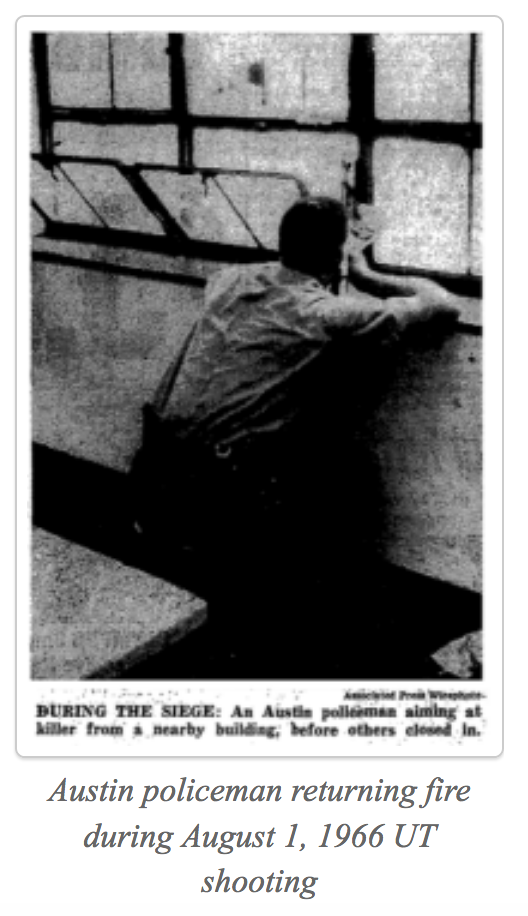
‘WELL-DOCUMENTED’ – Accurate reporting in the wake of the Whitman shooting
On August 3rd, a follow-up story included excerpts from candid interviews with Whitman’s immediate family, a reproduction of notes from Whitman’s psychiatrist, and a detailed consideration of remarks from expert physicians on the potential role played by a pecan-sized brain tumor found during Whitman’s postmortem examination. All such content was unambiguously presented to the public in less than 48 hours via the nation’s “paper of record,” and remains as evidence of how such horrific events were chronicled in recent US history.
University of Iowa Shooting – 1991
Indeed, the initial historical record established by journalists on the scene suggests that specific and unequivocal information on other US mass shootings has been speedily related to the people. For instance, in the late afternoon of Friday, November 1, 1991 Gang Lu, a doctoral candidate studying physics at the University of Iowa, shot and killed four colleagues and wounded a college administrator and her assistant, the former dying of her injuries the following day. On November 2nd, news reports included eyewitness accounts and statements from university and area law enforcement officials describing how the event played out which suggested Lu’s possible motivations:
“A university spokeswoman, Ann Rhodes, said the student, Gang Lu … methodically searched out his victims. He had been disgruntled over his failure to receive an academic award for his doctoral dissertation, she said.”
The story continues to succinctly lay out the event’s chronology and resolution—each of which, if we are to conclude that the reporter was working on a deadline for the paper’s November 2nd late edition, were ascertained and related to the press within hours:
“A dreary, snowy school day had just begun to wind down when the shootings began at about 3:40 P.M. University officials and the police said the gunman came upon a group of students and professors in Van Allen Hall, the physics department’s building, and killed the four men [three professors and a graduate student colleague] without saying a word.”
“The professors had each been involved in Mr. Gang’s doctoral work, and the researcher had been a rival for the honor he sought, Ms. Rhodes said.”
“Mr. Gang then stalked out of the building and ran two blocks to Jessup Hall, the main administration building, which faces the campus common. There he injured the women in the office of academic affairs, where he had recently filed a complaint.”
The video below provides an overview of area police response to the shooting…
.
“The shootings lasted 10 to 15 minutes, said Iowa City’s Police Chief R. J. Winkelhake. Campus police officers responding to the shots found Mr. Gang about 10 minutes later, sprawled on an office floor beside a .38-caliber revolver. ‘He was alive at the time but with serious head wounds,’ Chief Winkelhake said.”

As in coverage of the UT Austin shooting, less than 48 hours later (November 3rd) an article elaborated on the investigation in a subsequent report, drawing on the observations of university and local police; no federal agencies or officials appear present:
“The discovery of five of Mr. Lu’s letters after the shootings has convinced investigators here that he had detailed plans to inflict deadly violence on a number of university employees,” Johnson County District Attorney J. Patrick White explained at a November 3 press conference.
Joined by the University of Iowa’s president, Hunter R. Rawling 3d, and other university officials, Mr. White today painted a portrait of a darkly disturbed man who drove himself to success and to destruction.
Despite the perception of Mr. Lu among those who knew him as an outstanding scholar in theoretical space physics, Mr. White indicated that there was a sinister edge to Mr. Lu’s character well before the shootings.”
“In the letters … Mr. Lu reportedly named his victims, said William Fuhrmeister, the university’s public safety director. None of the letters were ever mailed, the authorities said. Mr. Fuhrmeister, the university’s public safety director, said Mr. Lu had left instructions with acquaintances to mail the letters. The letters were apparently turned over to the authorities after the shootings.
In the letters, other targets besides the six shooting victims were also named Mr. White said, but he and other officials refused to disclose their identities.”
Other credible sources are on the record, further describing how the event was experienced. Dr. Van Allen, for example, “a professor emeritus of physics, was in the building when the shooting began at 3:42 P.M. ‘I didn’t hear anything,’ he said. “I was up on the seventh floor doing some work. At about 3:45 P.M. a young colleague of mine dashed into the office and said, ‘I recommend you don’t open the door until I hear it’s O.K.”
Unlike the hastily organized memorials following recent college shootings that curiously take place on the same day, Iowa’s university-wide service at the campus’ basketball arena was not held until November 7–almost a week after the shooting.
Stockton Elementary School Shooting – 1989
Details of other school shootings from years preceding the war on terror era are likewise swiftly and accurately provided in conventional news coverage, typically relying on eyewitness testimony and remarks from law enforcement and emergency response officials concerning the investigation and event.
On January 17, 1989, Patrick Purdy, a 24-year-old incorrigible with a substantial criminal record, brandished an AK-47 rifle to attack 400 to 500 Southeast Asian refugee children playing outside the Cleveland Elementary School in Stockton California.
A total of 30 sustained injuries and 5 of the children perished in addition to the gunman, who committed suicide following the assault. “He was just standing there with a gun, making wide sweeps,” according to teacher Lori Mackey. “She said she ran to her classroom window when she heard what she thought were firecrackers, and saw a man standing in the schoolyard, spraying gunfire … ‘There was mass chaos. There were kids running in every direction,” Mackey said.
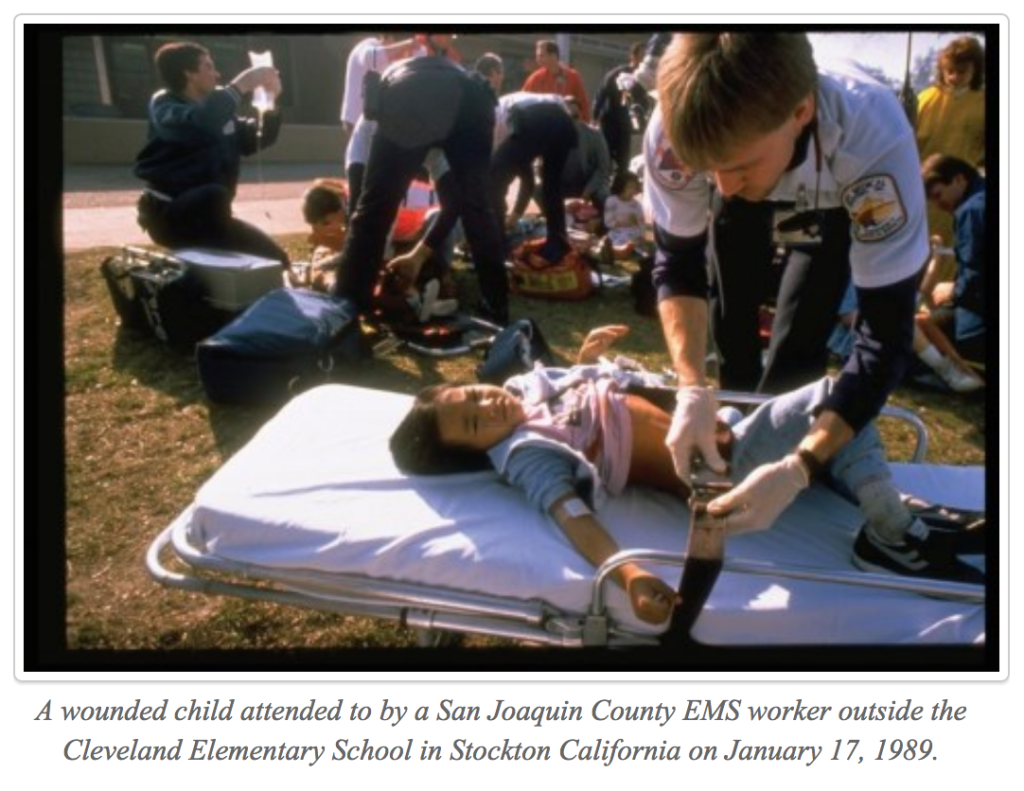
“There were a dozen students lying on the ground,” an 11-year-old’s mother of a Cleveland Elementary student told reporters. “It was very frightening.”
“Ramon Billed 3d, a student, described seeing a schoolmate shot. ‘I just saw him fall down,’ Ramon said. ‘His head hit the ground. the teacher grabbed him and dragged him inside the other classroom’ …
Another pupil, Roberto Costa said the shooting started during his reading class. ‘The bullets were hitting the walls,’ he said. ‘Everybody got scared.’” A passerby “heard gunfire and ran to the scene. ‘I tried to get a pulse, couldn’t get a pulse,’ he said, referring to a pupil. ‘I was hoping an ambulance would show up. It seemed to take forever.”
Again, in less than 24 hours reporters recorded the event, the background of the shooter and his every essential movement on the scene, even the number of bullets fired and the property damage caused via information from those assembling the criminal investigation and the recollections bystanders. “He opened fire on the west side of a group of portable classrooms,” AP writers noted,
“then moved to the east side and continued firing across the blacktop where children were playing toward the main building about 250 yards away, [Deputy Police] Chief [Lucian] Neely said. He was no closer than that when he shot himself in the head. About 60 rounds were fired; in some cases the bullets went completely through the main school’s building and came out the other side to fall spent on the L-shaped school’s front lawn, Chief Neely said.”
In follow-up coverage the crime scene is described via on-site accounts. “Overnight, workmen patched the 60 or so bullet holes in the south wall of the brown stucco building and scrubbed out bloodstains. But only about a quarter of the 970 pupils showed up.”
The assailant’s approximate movements in the prelude to the shooting are also recorded:
“On Tuesday, just before noon, [Purdy] arrived at the Cleveland School in his 1977 Chevrolet station wagon, burned the car with a molotov cocktail in a Budweiser bottle and walked onto the crowded school grounds. There he opened fire. He shot at least 106 rounds. “He was not aiming as much as spraying,” said Captain [Dennis] Perry of the Stockton Police Department. Children began to crumple. The shooting lasted about two minutes. Then Mr. Purdy put the pistol to his right temple and fell dead against a school wall.”
Concluding Observations
Journalists covering mass shootings twenty or more years ago usually relied predominantly on local police officials and eyewitness accounts to chronicle such events. Information related in such reportage was consistent and accurate in nature, and was quickly related to the reading public. Such reports were produced at a time when news organizations often had only telephone and facsimile to gather content.
In light of the above, and in particular the fact that we now live in an internet-fueled “information age,” how can one account for the the almost uniformly poor and sometimes cartoonish reportage of today’s mass shootings?
The overall coverage of shootings since at least 2011 has become unreliable and slipshod, with the Sandy Hook Elementary School massacre the foremost example of ambiguous, confusing and ultimately irresponsible reportage largely based on state and federal law enforcement officials commenting under the cover of anonymity. Federal agency involvement in homicide and similar crime investigations no doubt tends toward the potential politicization of such events. This is particularly the case as the leadership of the Federal Bureau of Investigation and Bureau of Alcohol, Tobacco Firearms and Explosives (ATF), and similar entities is appointed by the given presidential administration. Such bureaucrats understandably recognize their allegiance to this political power and are readily appease its given agendas.
Clear examples of federal interference in local and regional criminal investigations and attendant press censorship may be found in the major political assassinations of the 1960s, in particular the murders of President John F. Kennedy and Dr. Martin Luther King Jr., where significant public confusion still abounds.
More recently, the 1995 bombing of the Murrah Federal Building in Oklahoma City suggests a juncture where federal intervention [CSI takeover] became increasingly commonplace, ultimately transforming the narrative of that event and how it is called up in popular memory; from a demonstrable government “false flag” attack to a strike against America’s heartland by the enemy within–an unstable, anti-government drifter, comprising the template for the so-called “lone wolf,” a now commonplace term in US police state parlance.
Hungry for information to develop stories under deadlines and editorial pressure, journalists are effectively incapable of questioning the pronouncement of official sources. Fearful of alienating powerful relayers of information, they place in abeyance their common sense discernment of what may or may not be plausible to a situation where their understanding and expertise is limited.
This is all the more reason for the concerned citizen to take heed. The plethora of recent mass shootings and array of disorienting news accounts accompanying each should be carefully considered, particularly in light of the more trustworthy and consistent journalism of such tragic events from the 1990s and prior, a journalism far less subject to disinformation and unclouded by prevailing political agendas and goals.
Notes
[1] William J. Krouse and Daniel J. Richardson, Mass Murder with Firearms: Incidents and Victims, 1999-2013, Congressional Research Service, July 30, 2015.
[2] Daniele Ganser, NATO’s Secret Armies: Operation Gladio and Terrorism in Western Europe, New York: Routledge, 2005; Trevor Aaronson, The Terror Factory: Inside the FBI’s Manufactured War on Terrorism, New York: Ig Publishing, 2013.
[3] “Sniper in Texas U. Tower Kills 12, Hits 33; Wife, Mother Also Slain; Police Kill Him.” New York Times, August 2, 1966; “27-Story Tower Haven For Sniper,” New York Times, August 2, 1966, A1.
[4] Martin Waldron, “Whitman Told Doctor He Sometimes Thought of ‘Shooting People,’” New York Times, August 3, 1966, A1; Walter Sullivan, “Effects of a Tumor on the Brain Can Cause Antisocial Behavior,” New York Times, August 3, 1965, A20; “Text of Psychiatrist’s Notes on Sniper,” New York Times, August 3, 1966, A20.
[5] Steven Lee Myers, “Student Opens Fire at U. of Iowa, Killing 4 Before Shooting Himself,” New York Times, November 2, 1991, A8.
[6] Michel Marriott, “Gunman in Iowa Wrote of Plans In Five Letters,” New York Times, November 3, 1991, A26.
[7] “A Day of Mourning at University of Iowa: Funeral, Memorial Services for Shooting Victims Replace Classes,” Washington Post, November 5, 1991.
[8] “Five Children Killed As Gunman Attacks a California School,” New York Times, January 18, 1989, A1.
[9] Robert Reinhold, “After Shooting, Horror but Few Answers,” New York Times, January 19, 1989, B6.
***
Author James F. Tracy is a media scholar, educator and political analyst located in South Florida.
READ MORE DAILY SHOOTER NEWS AT: 21st Century Wire Daily Shooter Files












